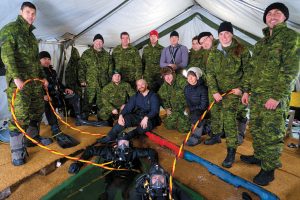Local divers chill out in northern B.C.
By Lookout on Mar 16, 2016 with Comments 0

Photos by PO2 Bibeau, FDU(P)
The Operational Dive Team poses for a picture during the ice dive exercise on Lac Des Roches in Lone Butte, B.C.
Katelyn Moores, MARPAC Public Affairs ~
An icy dip in Canada’s northern waters is not something most people would look forward to, but for Fleet Diving Unit (Pacific) (FDU(P)), diving in frigid and isolated conditions is an excellent opportunity to hone a unique and important skill set.
Last month, 16 divers from the Operational Dive Team, consisting of six Reserve Port Inspection Divers and 10 Clearance Divers, deployed to Lac Des Roches in Lone Butte, B.C., for a five-day ice dive exercise to ensure they are prepared to operate in Canada’s Arctic.
“Clearance divers have a mandate to operate in all Canadian waterways,” explained Lieutenant (Navy) Kevin Okihiro, the officer in charge of the exercise. “It’s important that we stay practiced in operating in these northern areas.”
The exercise aimed to combine the capabilities of the divers with those of the SeaBotix Remotely Operated Vehicle (ROV), a tethered robot controlled from land that provides real-time information on the underwater environment. Capable of traveling to a depth of 950 metres, the ROV allows the dive team to get a clear picture of what’s beneath the ice while eliminating the time constraint that decompression imposes on divers. After the ROV does an initial scan of the area, objects of interest can be further investigated by the divers.
Exercises like this one happen at least once a year and provide an excellent opportunity to familiarize the divers with Arctic operations in a demanding, real-world environment.
The cold weather isn’t the only challenge these divers faced. Lt(N) Okihiro said the main obstacle when operating in the Arctic isn’t the frigid temperature, but the remote location.
“The biggest challenge for us is getting there, setting up, cutting through the ice and having to operate with limited support,” he said. “The diving isn’t any harder, but the logistics of getting there are.”
The Lac Des Roches exercise was a success, helping the team build confidence in both their procedures and abilities in isolated, cold-weather conditions.
This confidence will be valuable later this month when FDU(P) divers head north once again. This time they will be participating in an exercise led by the Undersea Warfighting Development Centre’s Arctic Submarine Lab on an ice floe in the Beaufort Sea, 250 nautical miles north of Prudhoe Bay, Alaska. The bilateral operation will establish an ice camp to support a U.S. submarine exercise that includes participation from a number of organizations and militaries, including the United States Navy, the Royal Navy, the Royal Canadian Navy and the Royal Canadian Air Force.
The remoteness of Canada’s North combined with the lack of infrastructure requires a uniquely trained force to effectively operate in the area. By participating in exercises like these, FDU(P) divers ensure they remain trained and equipped to operate in Arctic conditions as they continue to enhance northern sovereignty in support of the Canada First Defence Strategy.
Filed Under: Top Stories
About the Author:





